
Internal talent marketplace for a global IT services company
Itransition created Talenteer, a comprehensive AI-driven internal talent marketplace providing a 360-degree view of the internal talent pool. The solution reduces employee turnover and recruiting costs and helps increase business agility, talent flow transparency and mobility.
Challenge
Itransition is a global team of 3000+ professionals providing consulting and software engineering services to clients across 40+ countries. We are a large-scale company rapidly growing in both the talent pool size and the number of offices worldwide. Continuously expanding into new markets and extending our service offering, Itransition has encountered the following talent management challenges:
- Talent siloing
With the information about available employees and open opportunities decentralized across numerous departments, Itransition needed more clarity into the open work opportunities and suitable in-house candidates. - Excessive external hiring
Insufficient transparency into the internal talent pool due to insufficient talent capacity management features in our HRM system resulted in professionals being hired externally while suitable candidates are available in-house. - Increased attrition rate
The lack of information about upcoming projects and open positions made it harder for Itransition’s professionals to find opportunities for growth, leading to increased employee turnover. - Insufficient business agility
Itransition needed to increase talent agility to rapidly address staffing needs in an unpredictable business environment. - High costs
With the internal talent pool underutilized, Itransition spent extra resources on employee retention, external hiring, and onboarding.
Overall, rapid business expansion resulted in inefficient talent allocation and distribution. This is why we wanted to revise the existing processes and enhance them with an internal talent marketplace. The solution would simplify the process of managing internal work opportunities and staffing them with in-house employees.
However, the internal talent marketplaces currently available on the market haven’t fully met our business needs. Most such solutions focus only on employee career pathing, but we needed more features for talent capacity management and analytics to help managers efficiently handle our talent pool. The majority of ready-made solutions also offer skill-centric workforce management, but they lack features for distributing talent as per hours and rates, and since our company has a project-based organizational structure, we needed these features to efficiently distribute the workforce among hundreds of projects. Moreover, all the existing solutions are built on a SaaS delivery model, and we preferred to leverage an on-premises solution that would provide greater security due to full control over sensitive employee data.
Thus, Itransition decided to develop a custom HR system tailored to solve the workforce management issues faced by large-scale companies.
Solution
We created Talenteer, a comprehensive AI-driven internal talent marketplace that provides a 360-degree view of the internal talent pool. The solution is aimed at minimizing employee turnover and reducing recruiting costs while improving business agility, talent flow transparency and mobility.
Talenteer enables managers to track employee capacity, create new opportunities, and staff them with in-house professionals, providing analytics features to gather insights into the talent flow.
Employees can also benefit from a range of features that help enhance the professional growth and job satisfaction. Via Talenteer, employees apply for work opportunities and find in-house mentors, taking a more proactive approach to their careers.
Features for managers
Managing team capacity
Talenteer helps managers plan and track available employee capacity in their departments. The solution significantly simplifies talent management by helping managers centralize and structure all vital employee data in a single point of truth.
Managers can access all the basic information about their employees, including roles, levels, skills, etc. Additionally, Talenteer has a status field reflecting the employee's current workload and capacity, such as: Available, Available soon, Internal project, Project change request, Occupied, etc. Via an integration with the HRM system, Talenteer can provide managers with comprehensive employee data without them leaving the platform.
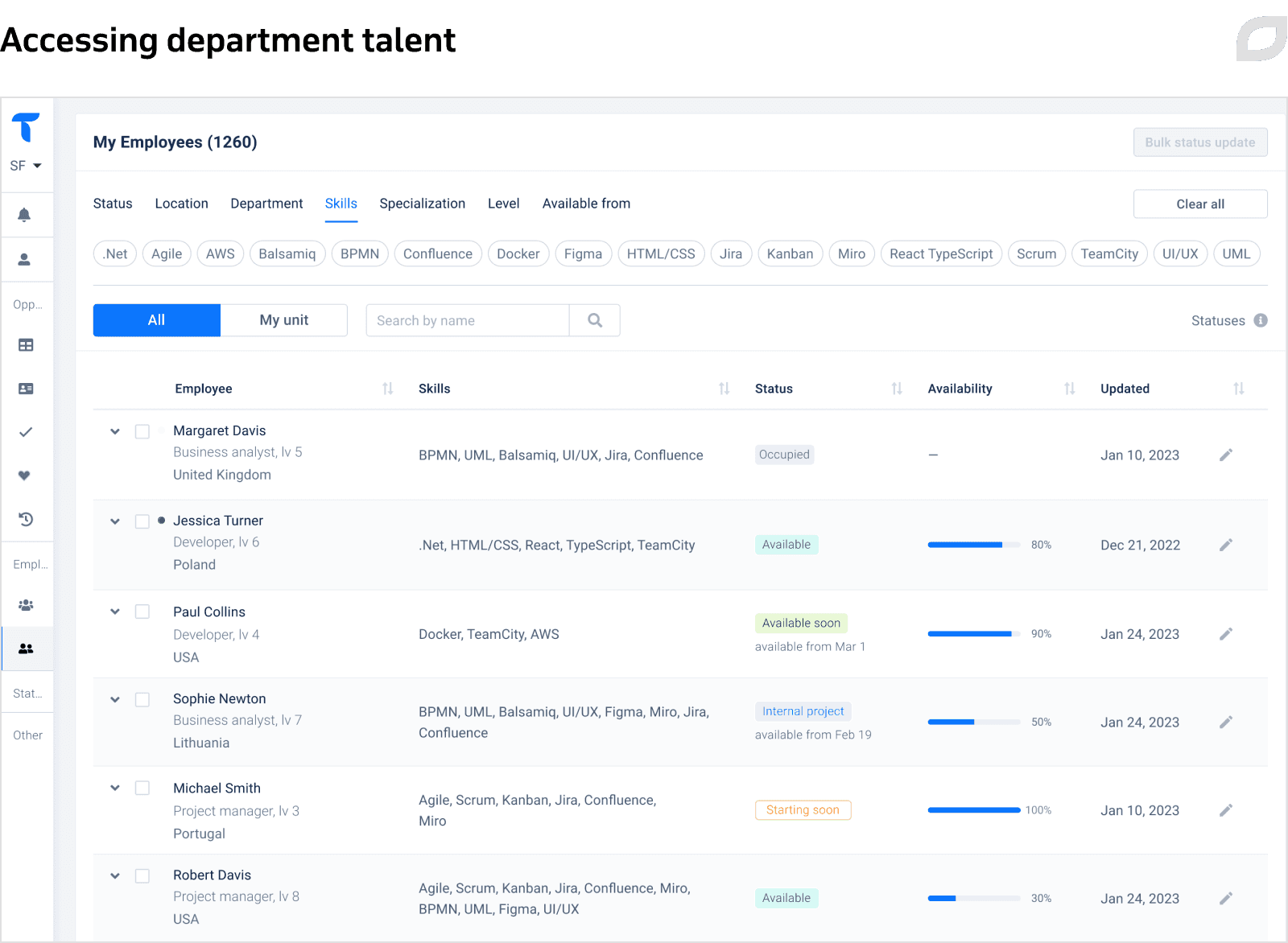
When updating information in employee profiles, managers write free-form comments about employees in their teams, sharing information that would be helpful for staffing managers. For example, a manager can emphasize that an employee is experienced in the retail domain, which would simplify the search when a candidate for an ecommerce project is needed.
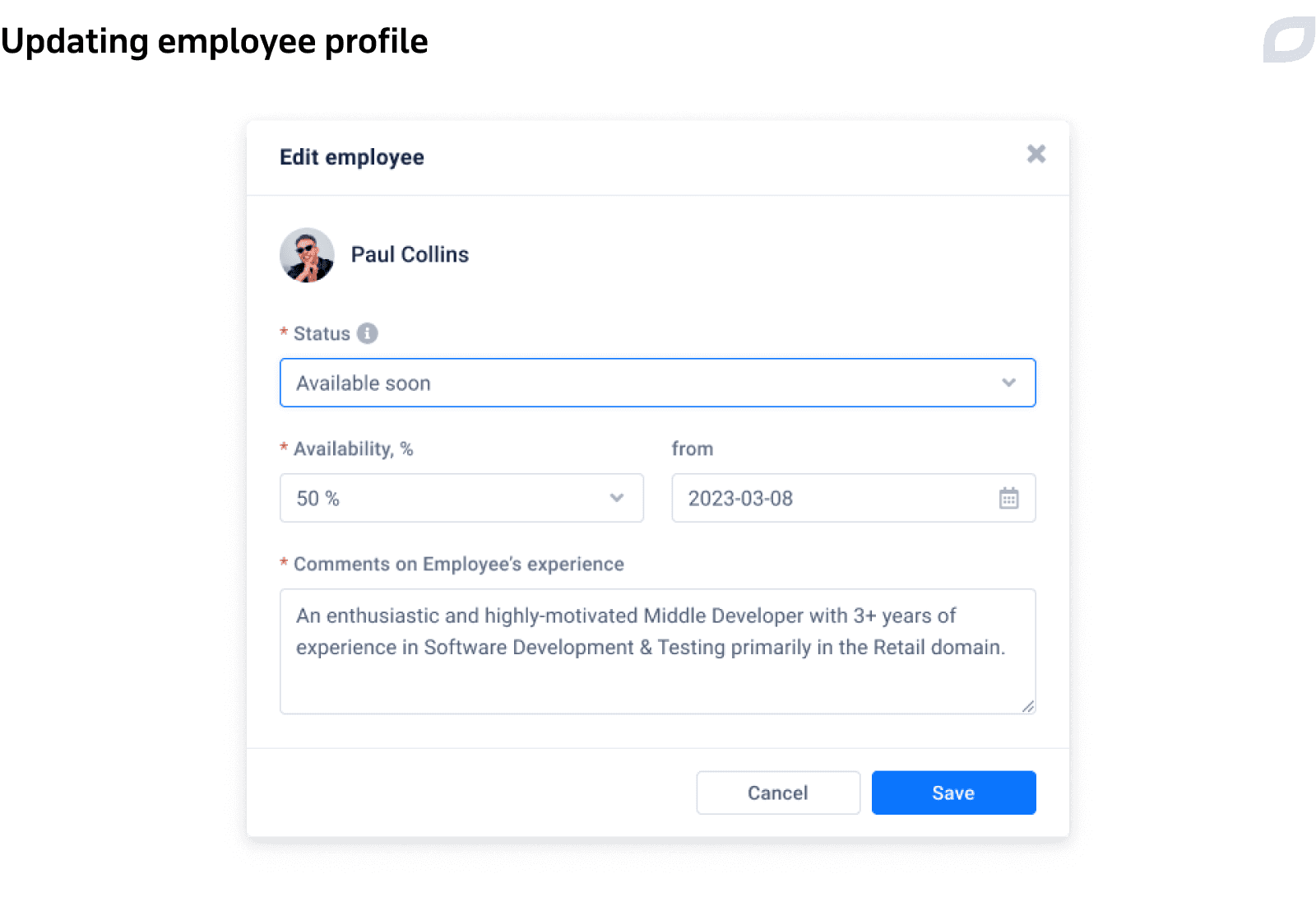
Finding suitable candidates
Talenteer prevents excessive external hiring as managers can easily check whether a suitable candidate is available in other departments and units.
To find a suitable employee, managers filter them by several parameters reflecting key employee information – role, main technology, level on the skill matrix, and more.
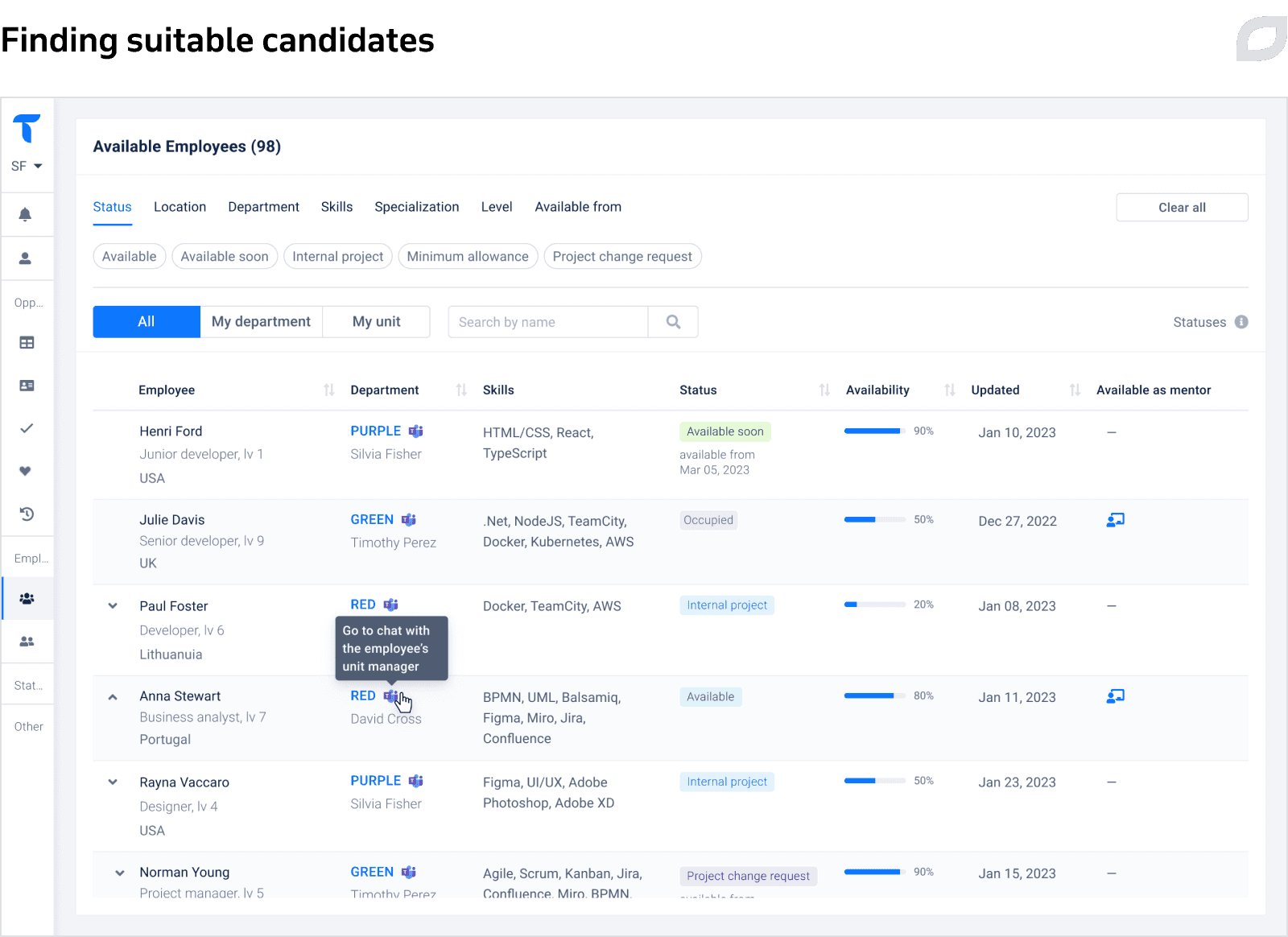
Due to the integration with the HRM system, managers can also access all the necessary candidate information in Talenteer employee profiles.
To move further with hiring a candidate, managers first need to sync with the manager currently overseeing the employee. To simplify the start of a discussion, we developed an integration with Microsoft Teams, our corporate communication platform. Talenteer directs the manager to a chat with the necessary person, without the need to find them in the contacts.
Creating company-wide opportunities
Talenteer allows managers to create new opportunities and post them on the internal talent marketplace available to all Itransition employees. Our team developed three opportunity types: project work, job position, and volunteering.
The dashboard for new opportunities is by default split into three main sections: opportunity, project, and candidate requirements. However, depending on the opportunity type, certain fields can be omitted. For example, job position opportunities do not include information on projects an employee would be temporarily engaged in.
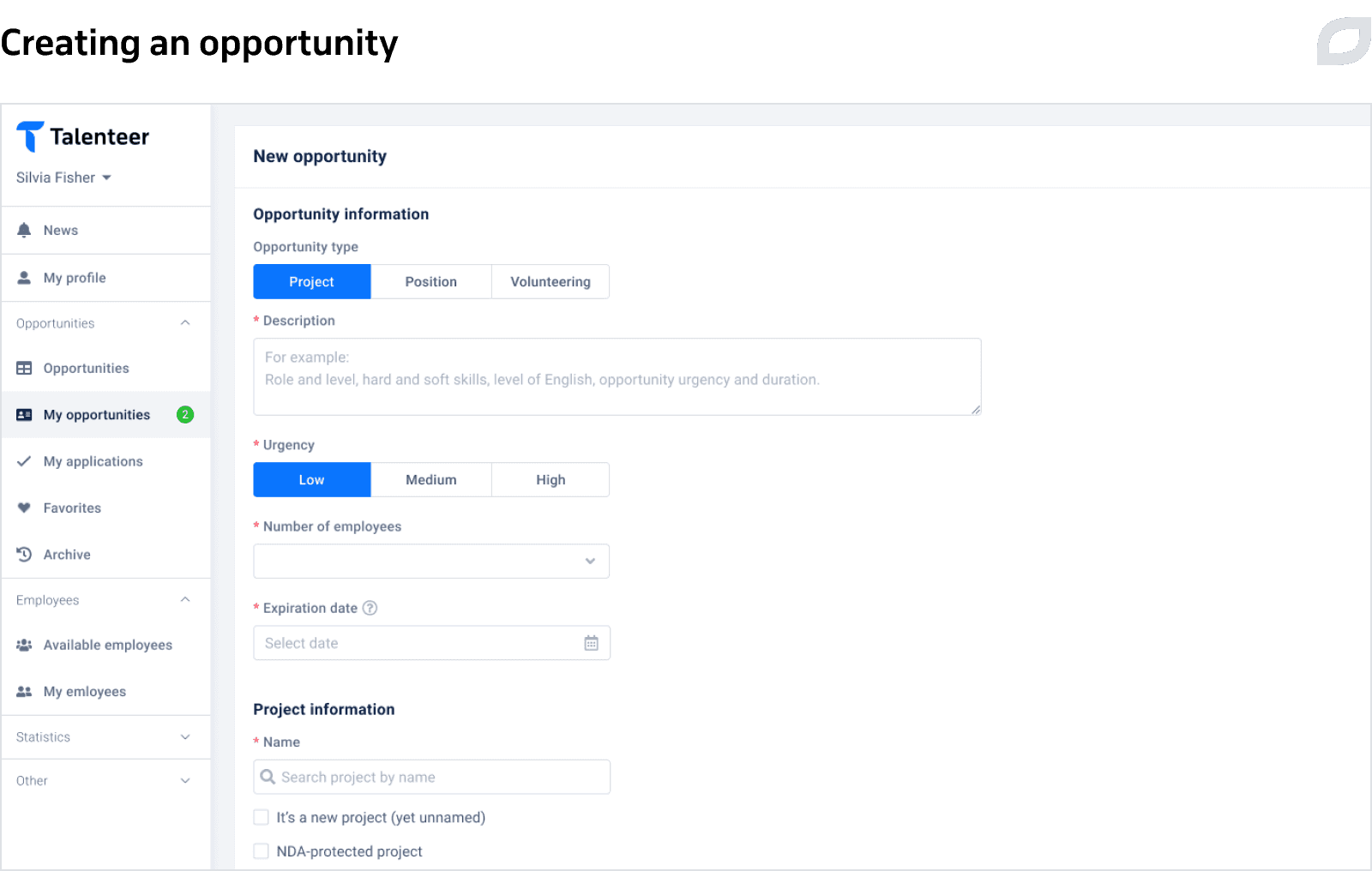
Available opportunity fields
| Opportunity | Project | Candidate |
|---|---|---|
| Description | Name | Specialization |
| Urgency (high, medium, or low) | Department | Min. level on the skill matrix |
| Number of employees | Engagement (full- or part-time) | Skills |
| Description | Level of English | |
| Location (certain location or global) |
Our team also added a payments field, where managers enter information on the opportunity’s salary range. This information is available only to certain user groups (e.g., managers and pre-sales specialists), ensuring that only selected professionals have access to sensitive financial data.
Managing applications
We developed a feature that allows managers to review applications and respond to them. Each opportunity has a subtab with submitted applications, displaying short information about each candidate and links to their Talenteer profiles.
To streamline and standardize application management, Itransition added a system of statuses reflecting the most important stages of internal staffing, including:
- Pending – the application needs reviewing
- Invited – the manager decided to set up an interview with the candidate
- Rejected – the manager decided not to proceed with the application
- Revoked – the candidate decided not to participate in the opportunity
- Approved – the candidate was selected for the opportunity
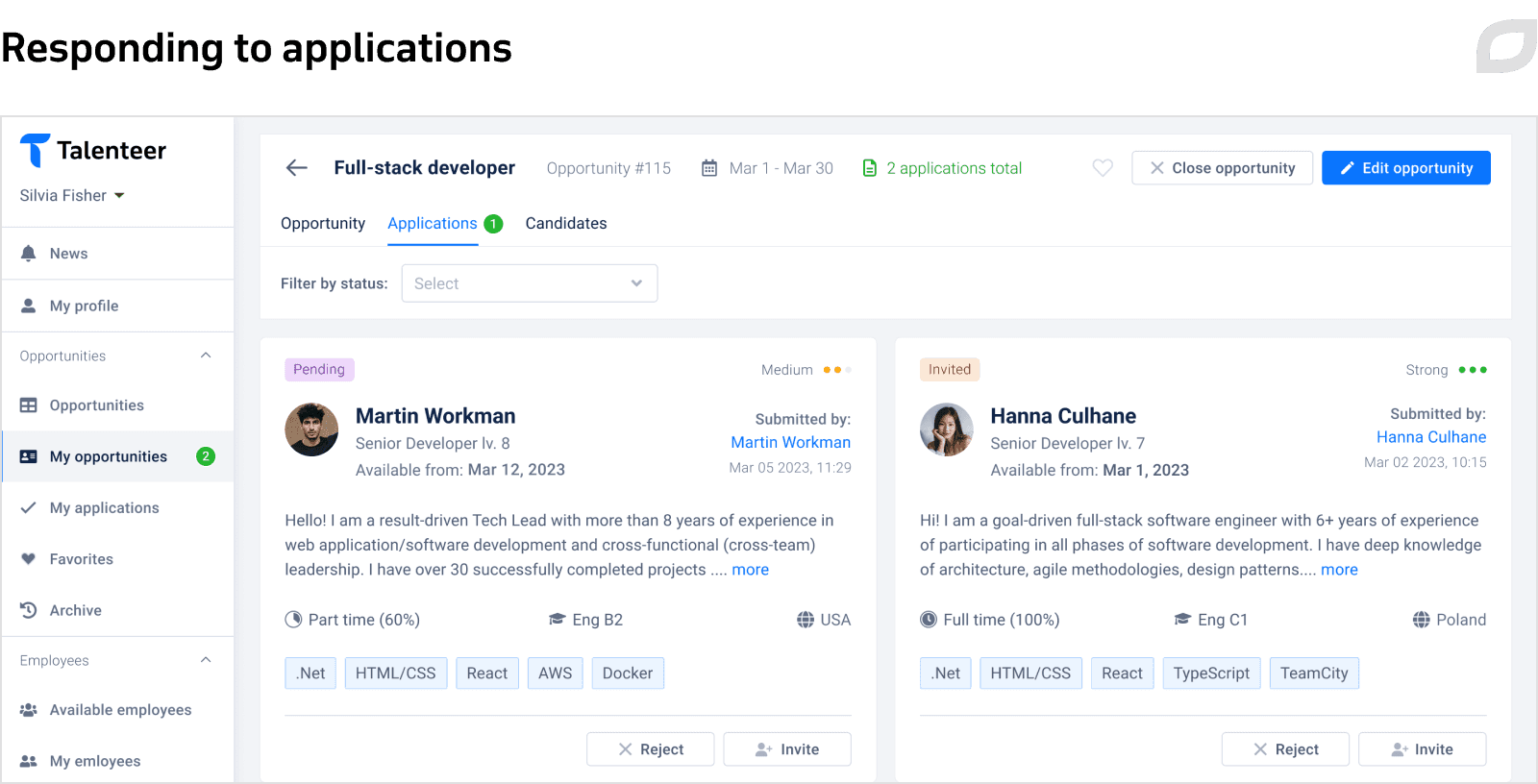
All the stages of application processing remain visible through the Responses, displaying the status change, its date and time, and the person responsible for it.
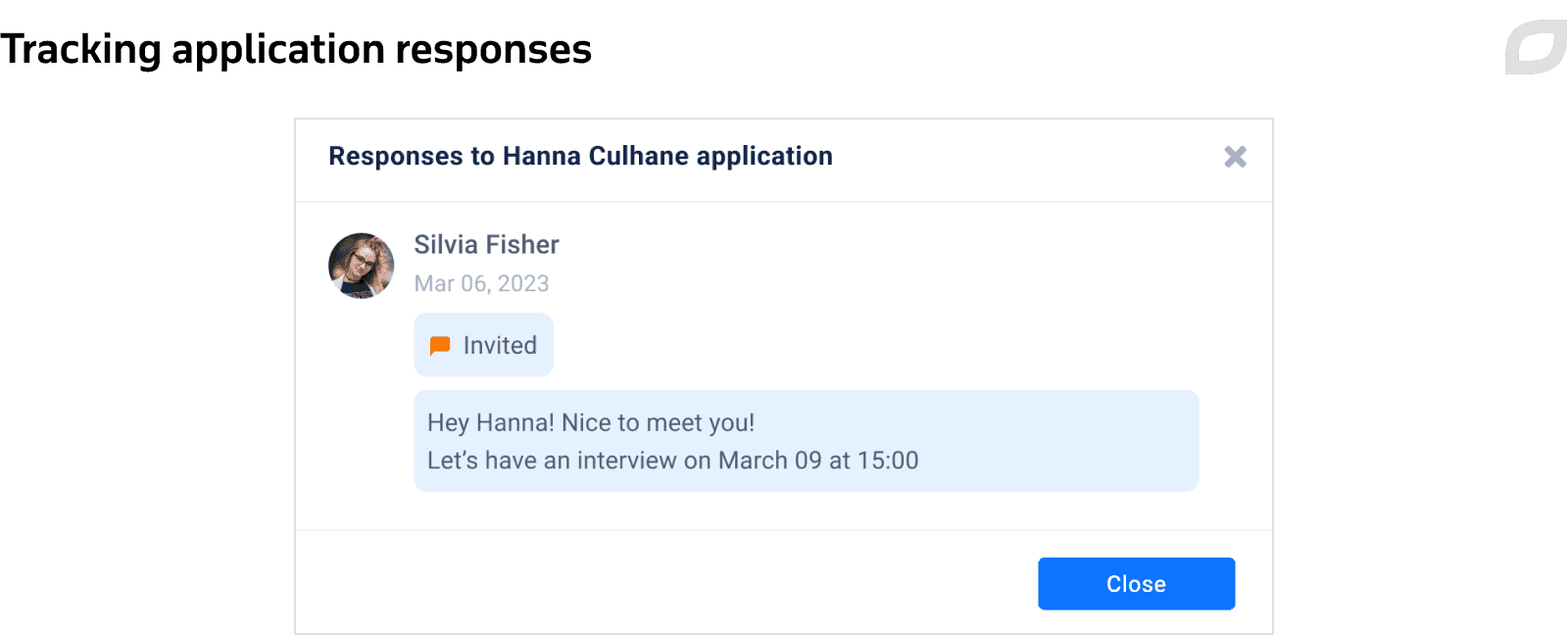
If managers decide to reject a candidate, Talenteer requires them to select a reason from the drop-down menu and write a short personalized message. Our team made these fields obligatory to ensure employees would still benefit from applying by getting feedback that outlines areas for future improvement.
Tracking staffing with analytics
Itransition developed analytics features that help managers aggregate data on opportunities and employees and assess the results of the staffing process.
With opportunity-related analytics, managers clarify what works well within the current staffing process and what could be altered to make it more productive. Dashboards display a detailed breakdown of data on the existing and new opportunities per department or unit, calculate the mean number of applications, average time to hire, etc. Managers filter the metrics by selecting the relevant time period, unit, role, or technology. We also added dashboards that analyze the frequent reasons for closing opportunities or rejecting candidates, helping managers notice trends or recurring issues.
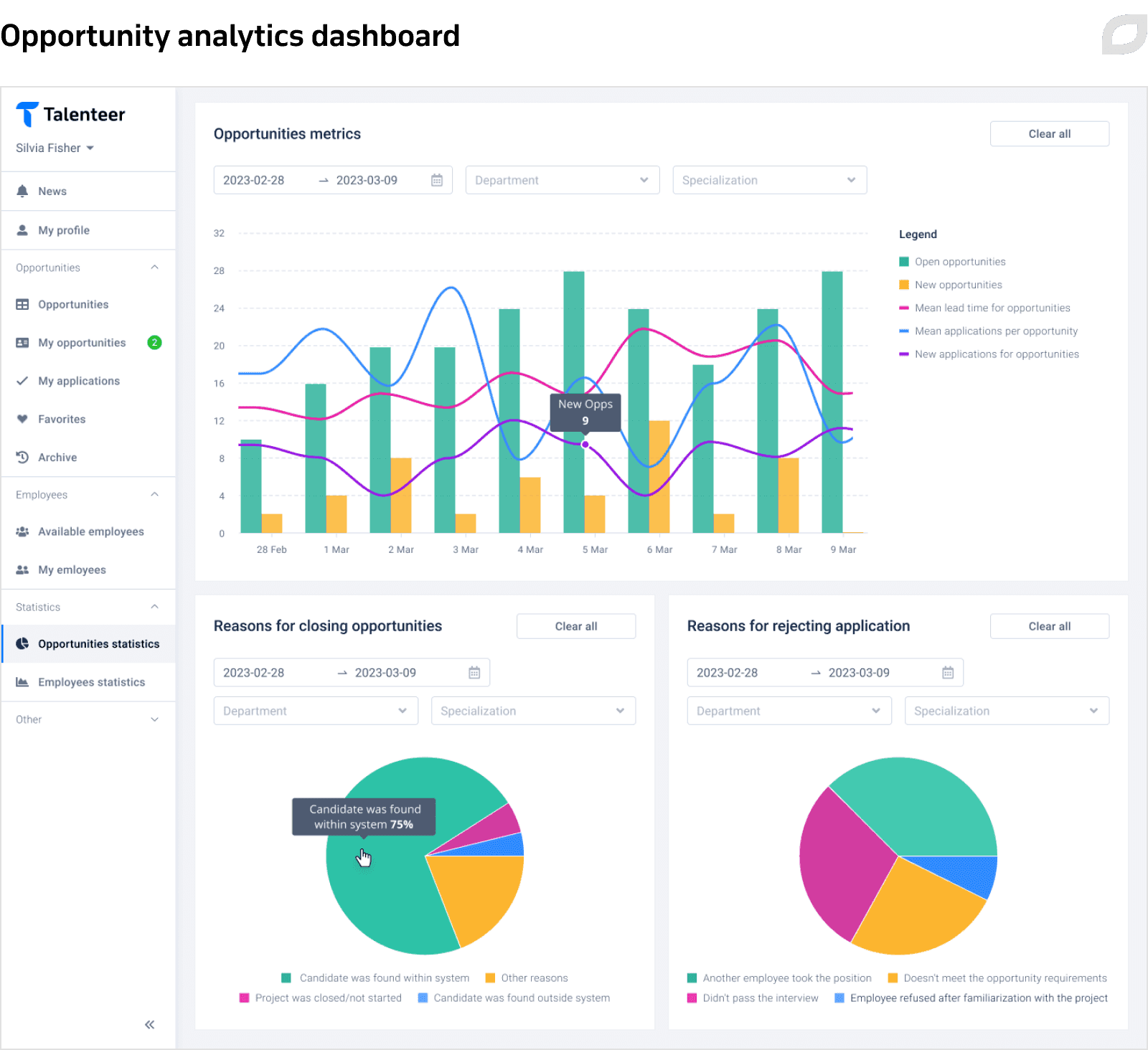
Talenteer also has dashboards for employee metrics, aiding managers in assessing employee capacity and popularity of internal opportunities to distribute talent more efficiently. The solution calculates the number and frequency of employee visits across departments or units per each opportunity to help managers gauge what opportunities draw the most attention. It also tracks the percentage of employee availability to provide clarity on what departments could be over- or understaffed. Thus, Talenteer helps managers understand what career direction to point unoccupied employees towards.
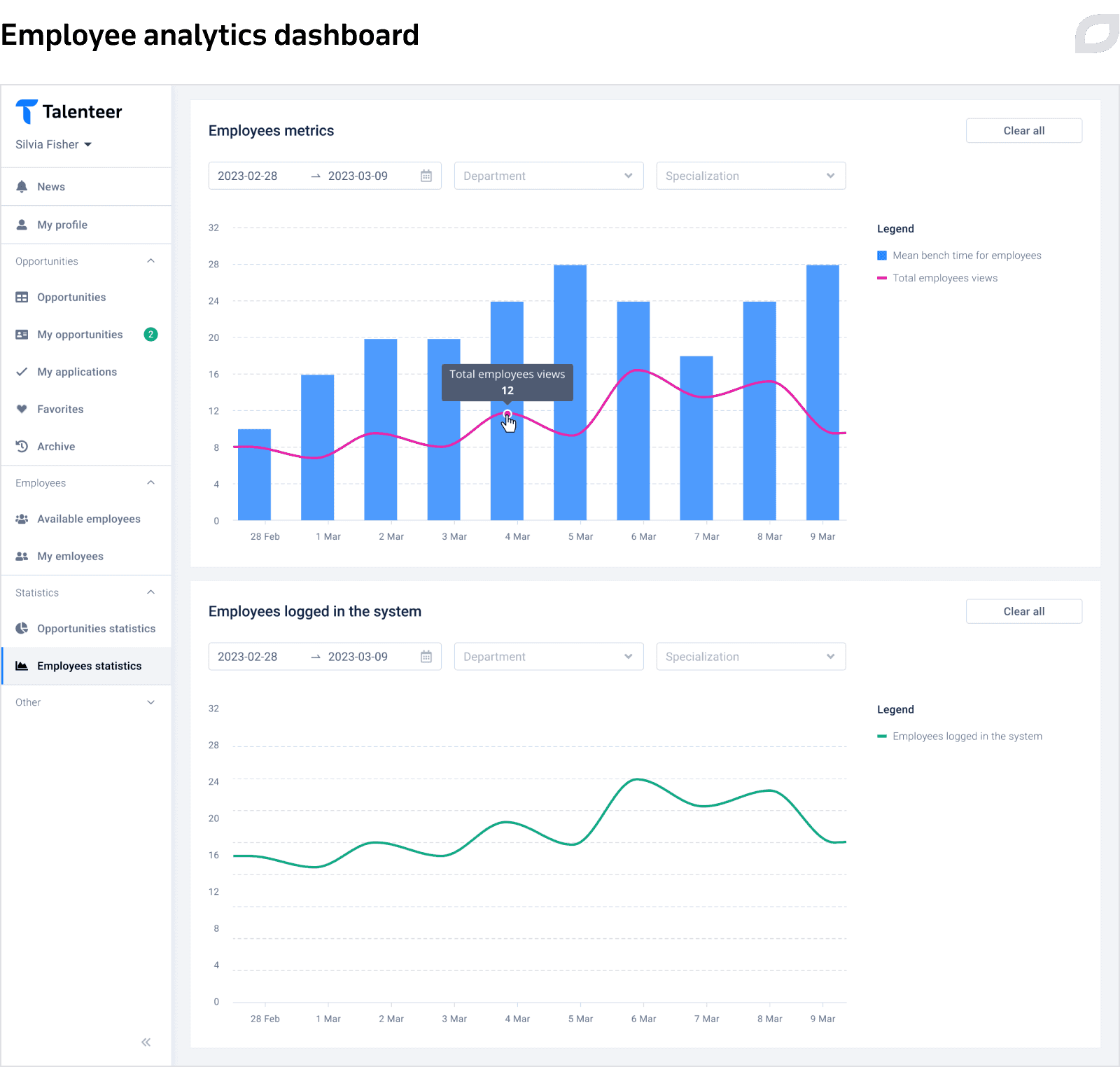
Features for employees
Editing personal profile
On Talenteer, employees can customize their profiles, add and edit skills to expand on their experiences, and show what career direction they are interested in to provide a more comprehensive description of their capabilities and interests.
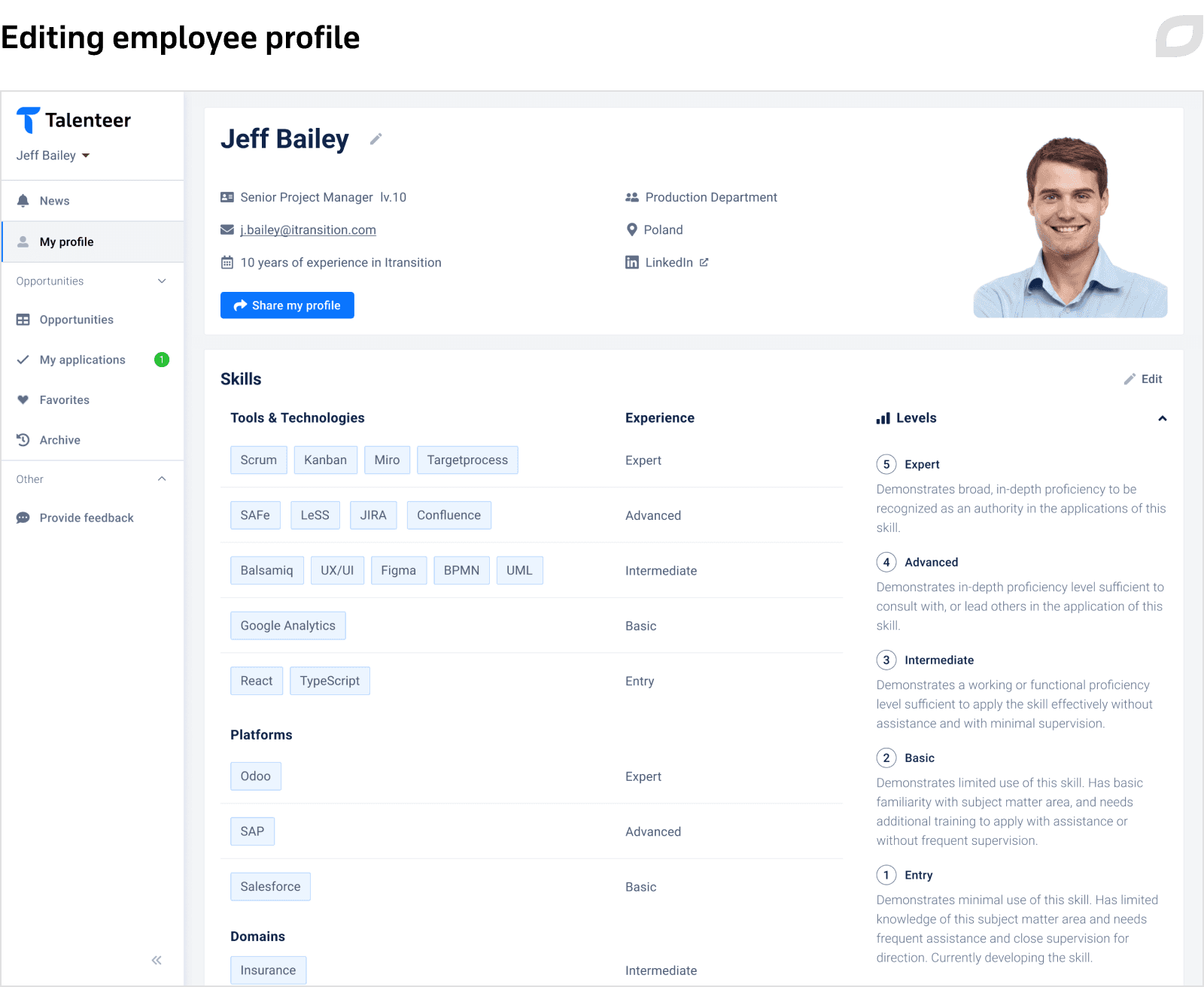
When employees apply for an opportunity, career and personal information is automatically retrieved via the HRM system integration, ensuring information consistency and simplifying the process.
Selecting opportunities and applying for them
Each opportunity first displays only the vital candidate requirements and project information. Users can like preferred opportunities and easily find them on the Favorites tab later. If the user clicks on the opportunity, the system opens the full opportunity and candidate description.
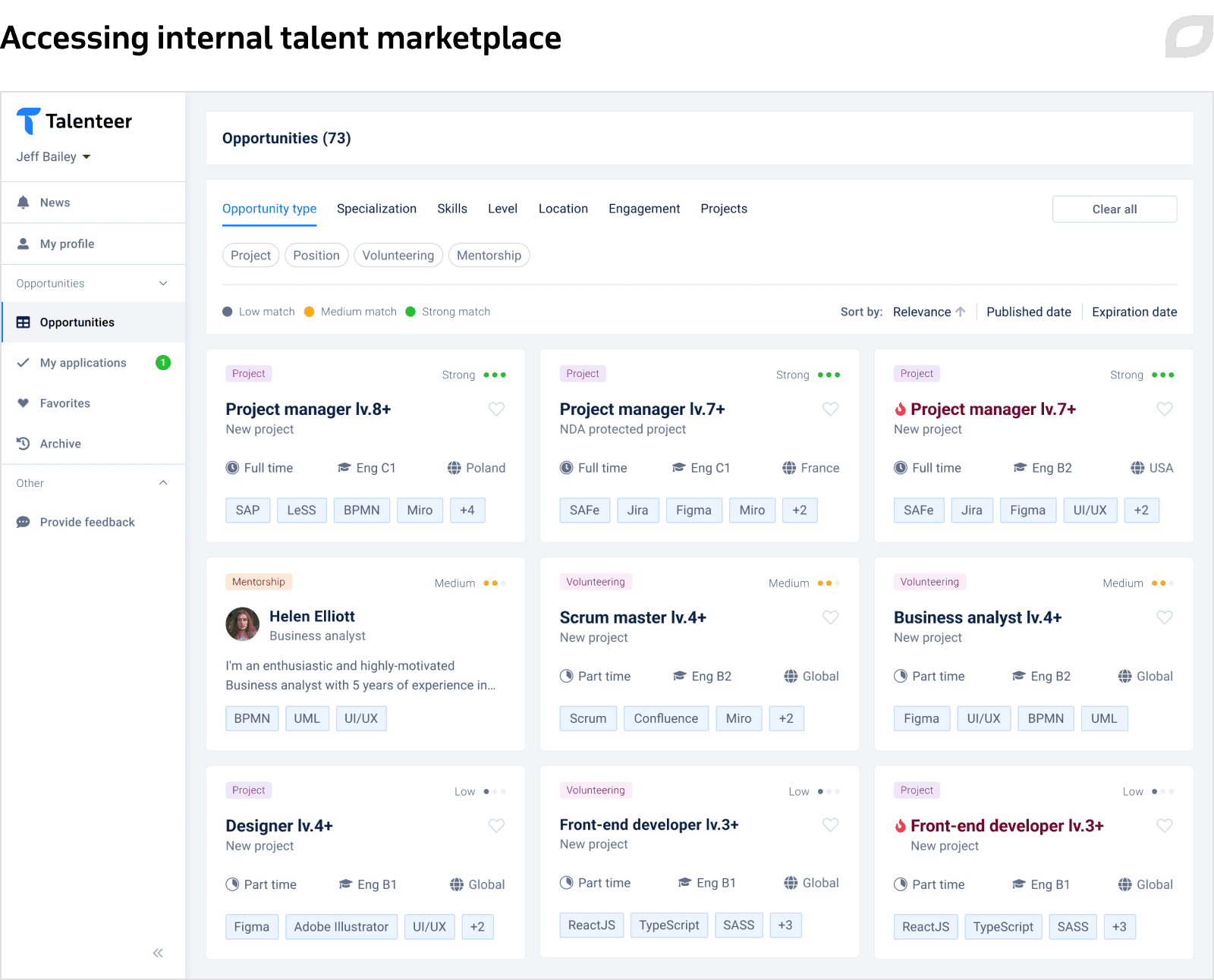
Users also have access to all the Talenteer opportunities that no longer accept applications. By analyzing all the closed opportunities, users can get a better understanding of skills that are frequently in-demand and hone them.
Employees either apply for the opportunity themselves or their manager suggests them as suitable candidates on their behalf. When submitting the application, users need to enter the date of availability and write a short accompanying message.
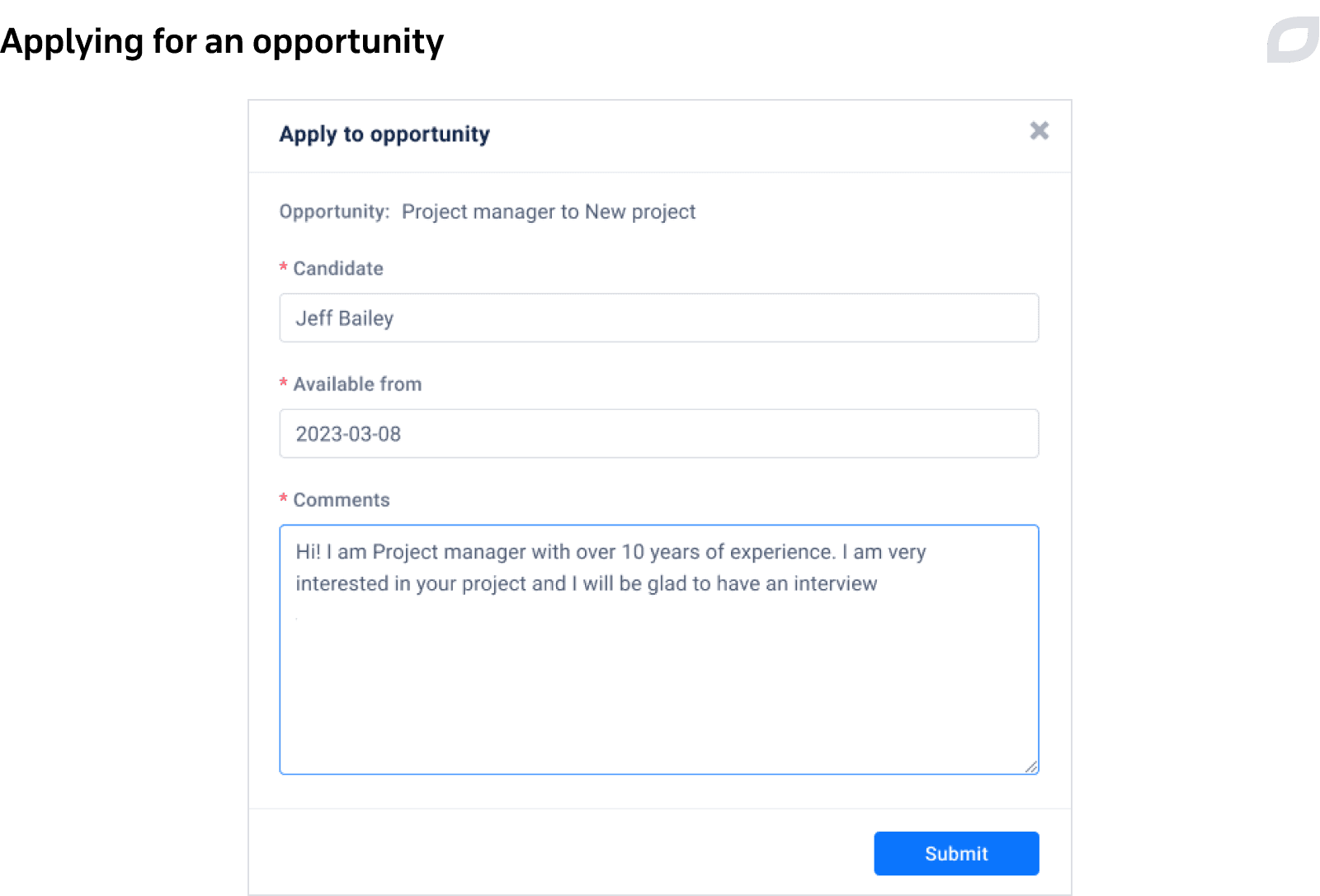
Employees manage their own staffing process by tracking the opportunities they’ve applied for. Talenteer displays all the submitted applications to both open and closed opportunities, their current statuses, and the history of responses.
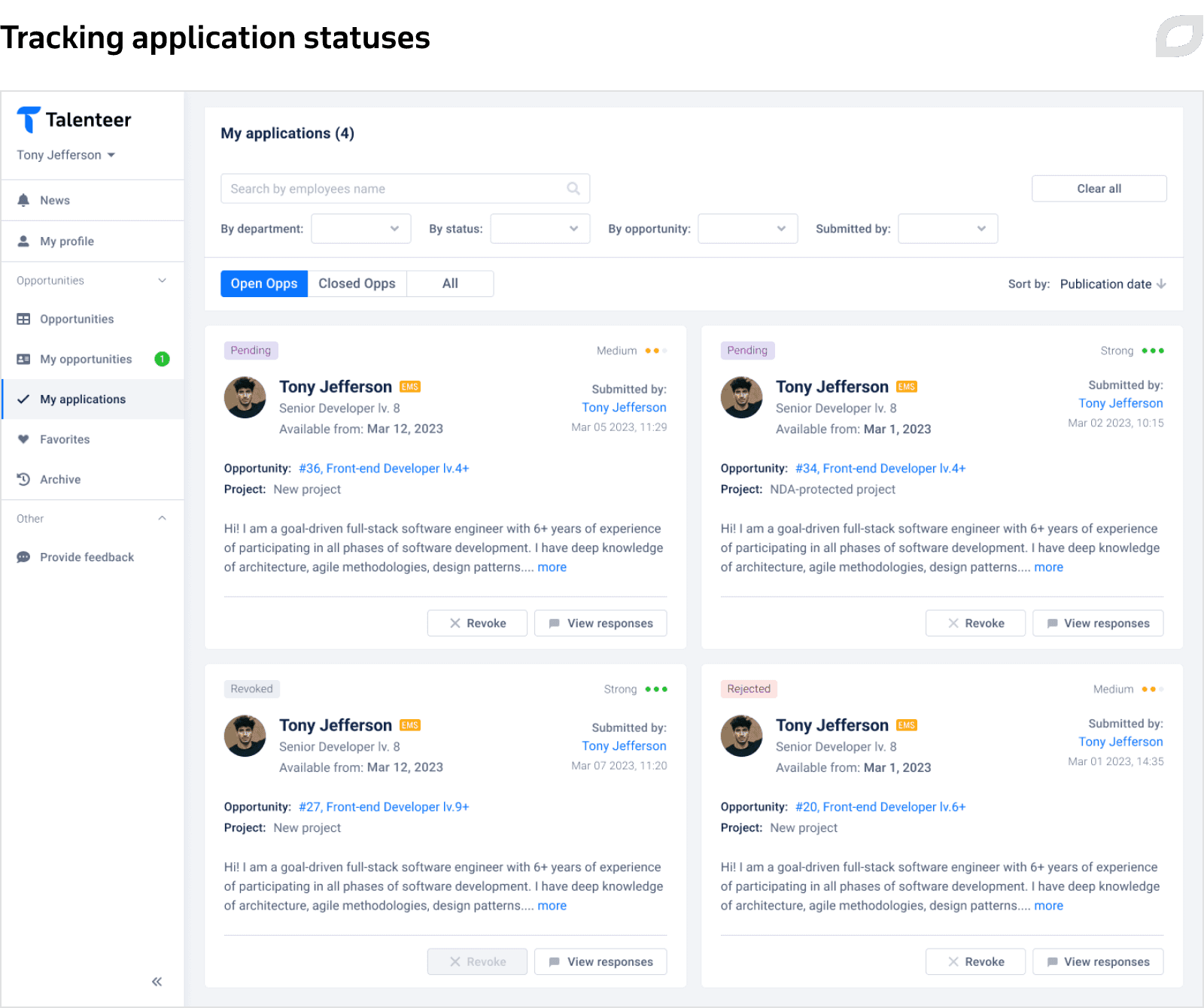
Mentoring
Our team wanted to ensure the solution would be leveraged not only for internal staffing but also for learning opportunities to facilitate employee career growth. Thus, we created mentorship features that help employees develop a skill set by connecting them with more experienced colleagues willing to share expertise.
Becoming a mentor
To become mentors, employees need to describe their career experience and approach to mentoring on Talenteer and mark whether they are currently ready to take on more mentees. As with work opportunities, core information is automatically retrieved from the HRM system.
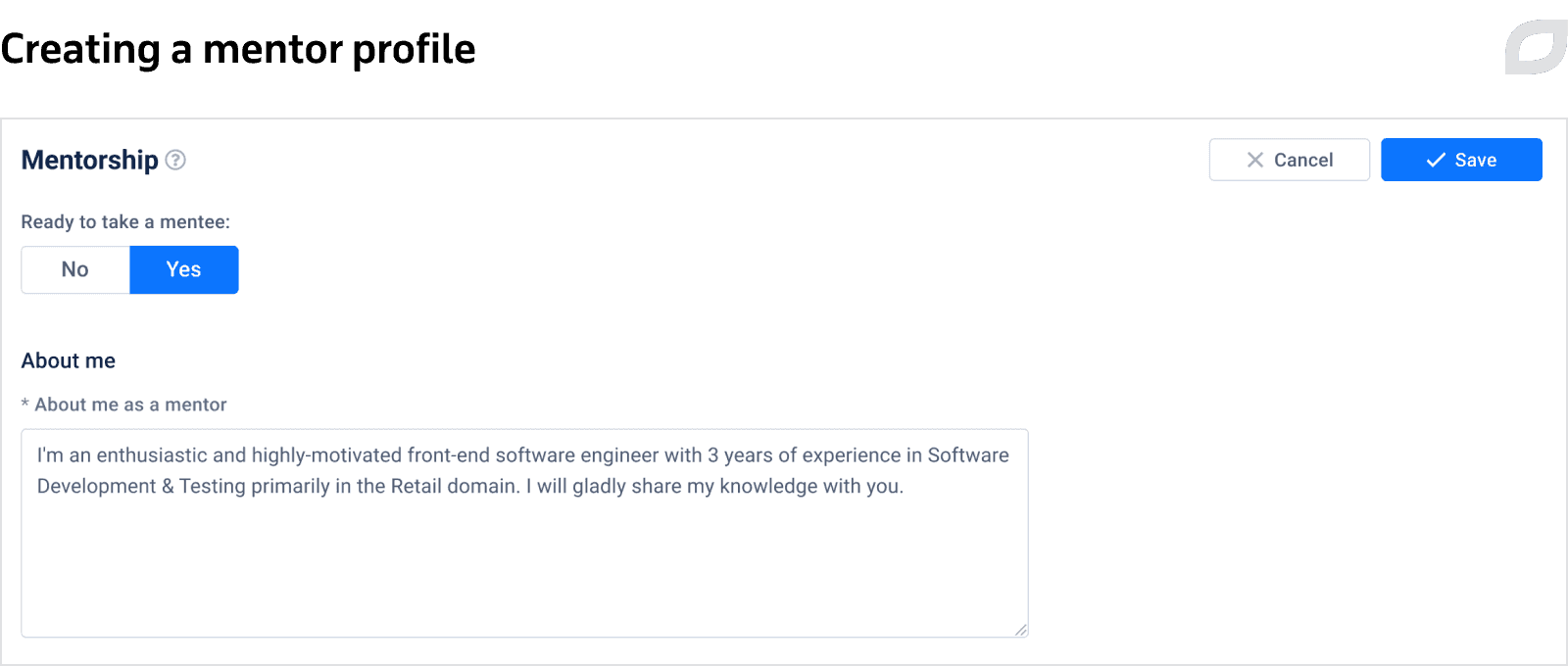
Applying as a mentee
The process of finding a mentor and applying to them is similar to finding work opportunities.
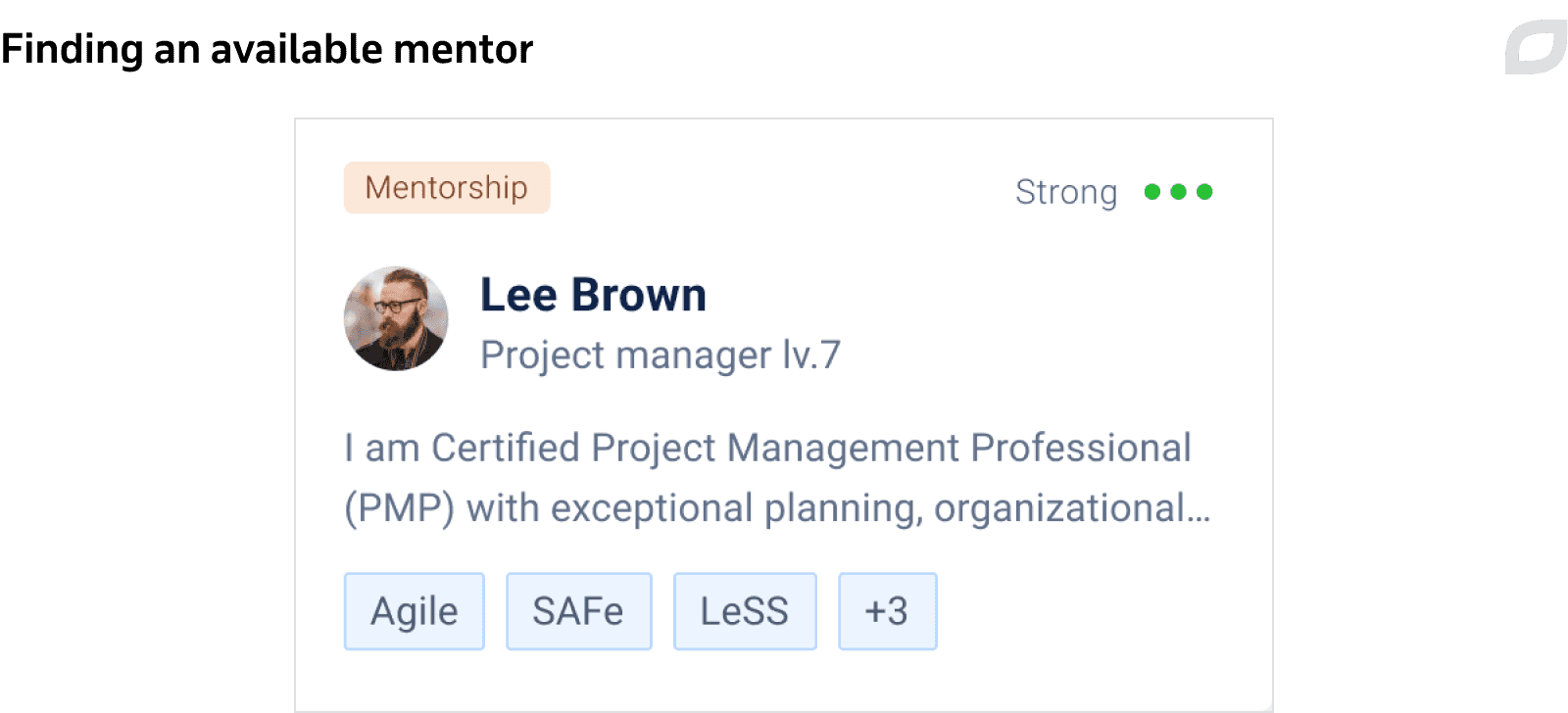
When an employee applies as a mentee, Talenteer prompts the user to write a personalized message to the mentor. Then, via an integration with Microsoft Teams, Talenteer creates a group chat with the employee, the selected mentor, and the employee’s manager. We opted for initiating a head-on conversation since the mentoring process is less standardized as opposed to staffing.
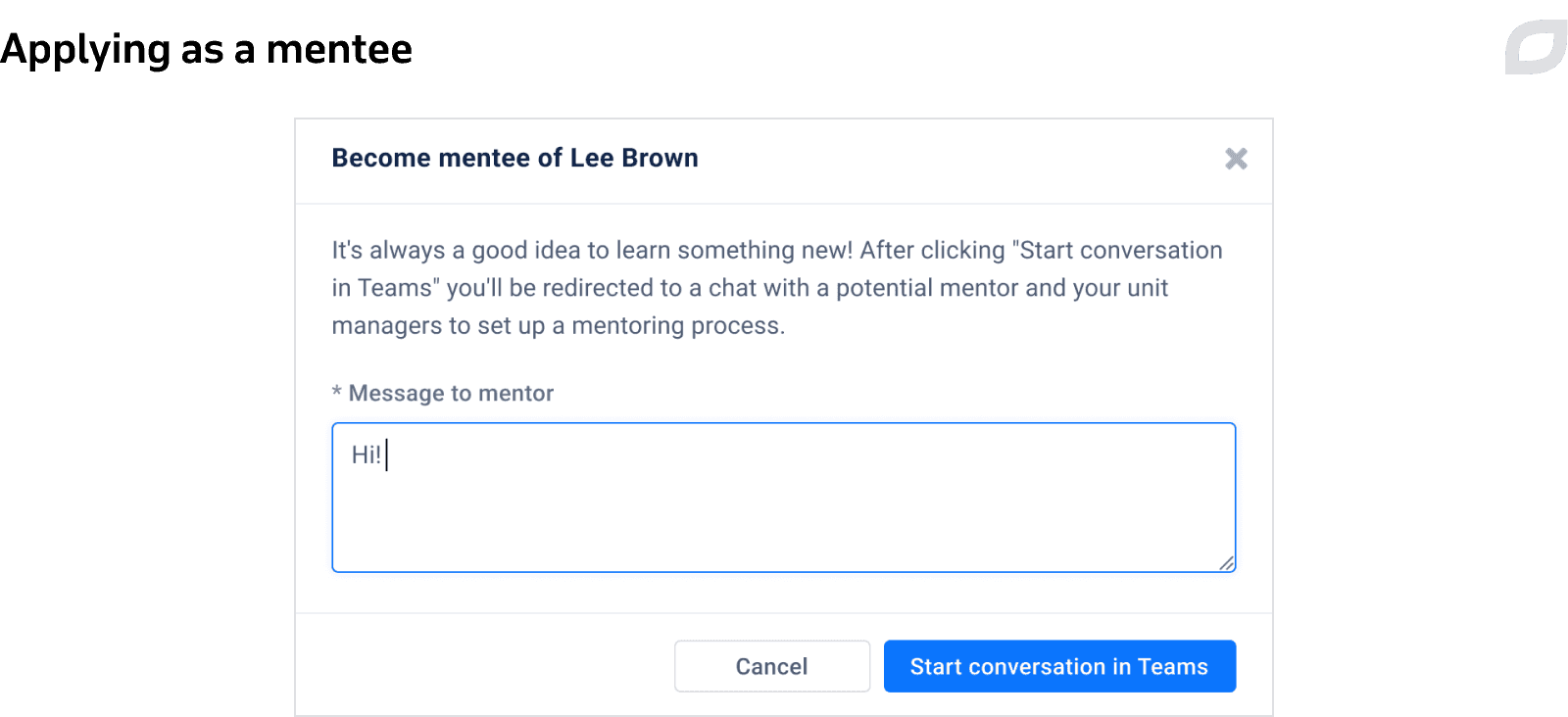
AI matching and tags
We developed AI-powered matching and tags features to simplify navigation and avoid overloading users because Talenteer contains a large amount of data on opportunities and candidates.
With the AI matching feature, Talenteer displays the most suitable opportunities to employees and the perfect candidates to managers. For this purpose, our team utilized Weaviate, a vector search engine. First, the engine employs text recognition to gather all the data required for effective matching on Talenteer: role, level on the skill matrix, main skills, location, etc. The solution then tracks all changes to candidate or opportunity information, reinitiating the matching with updated data. Then, the engine turns the data into vectors, compares them, and calculates a similarity score. The higher the score, the more well-suited the opportunity is. When calculating, the engine takes into account multiple parameters with different weights attached to them, making sure that more important factors have a stronger impact on the matching results. For example, because skills help form a more nuanced view of the candidate, they affect the similarity score greater than the current level on the assessment matrix. At the final stage, the engine ascribes one of three statuses reflecting their suitability to the candidate-opportunity pair: low, middle, and strong matching. Talenteer displays the matching results by relevance, ensuring the most suitable opportunities and candidates would be located at the top of the page.
The system of tags split into categories further simplifies finding a suitable opportunity. Users filter opportunities by selecting one or several tags in multiple categories, creating narrow search queries. In addition to cross-filtering, users can sort opportunities by publication and expiration dates.
News and notifications
Itransition wanted to accelerate the internal hiring process by ensuring that all involved parties would get timely notifications on an opportunity or application updates. Moreover, our team aimed to encourage the regular use of Talenteer among employees.
With these two objectives in mind, Itransition developed email notifications and Talenteer news. We used Microsoft Outlook, a familiar tool for our employees, to send immediate notifications to users. Talenteer sends emails throughout the whole staffing process, notifying about updates on the opportunities or candidates. For example, when an employee applies for an opportunity, the system alerts both the manager who created the opportunity and the manager overseeing the employee.
Users also find personal notifications in the condensed form on the news feed. Itransition added the news feed to give Talenteer a slight social network feel which would motivate users to regularly check the solution. The comprehensive news stream features information about all the new and closed opportunities so that employees wouldn’t miss important information. It also provides updates for management that notify about a fully or partially available employee.
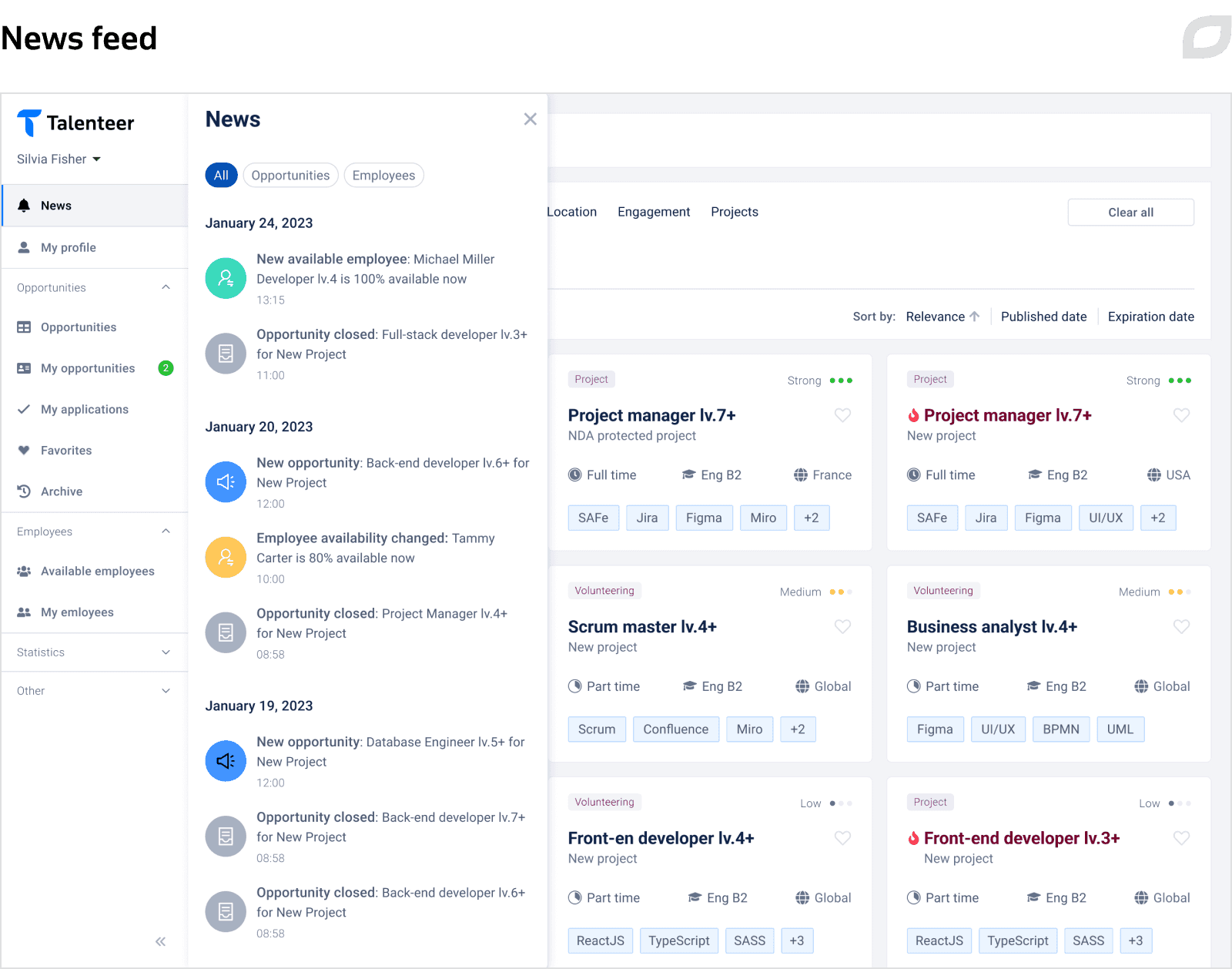
Process
We started creating Talenteer by forming a high-level vision of the solution. To elicit user needs and pain points, we collaborated with employees and managers across the Itransition vertical, from employees to C-level executives. Our team then presented the high-level vision of the solution to C-level stakeholders.
Next, we prioritized the marketplace’s features and developed more detailed requirements. First, we developed more mission-critical features that covered the most pressing management issues. Thus, the first release included the internal talent marketplace and management-only functionalities that help manage team capacity and staff opportunities with the available talent. We soon delivered analytics features, further assisting managers in distributing talent. Having developed the core functionality, Itransition focused on enhancing Talenteer with more employee-centric features, such as profile customization, mentorship, and more.
Before releasing each feature, we conducted user acceptance testing and collected feedback. To ensure smooth user adoption, our team prepared guides and manuals, recorded educational videos, and showcased Talenteer in company-wide workshops. Thus, we familiarized employees with the solution and answered frequently asked questions. After feature releases on the production environment, our team continued to gather feedback via an internal form, Jira support, and email. Itransition also launched a Talenteer satisfaction survey to get a 360-degree view of user opinion. The collaboration with our target audience helped us better tailor the solution, achieving an 8/10 average satisfaction rating.
Results
After we developed Talenteer and integrated it into our talent management processes, our company saw the following business benefits:
- 2x increase in internal recruitment
- 15% decrease in mean lead time for opportunity
- 5x reduction in onboarding resources as compared to onboarding external candidates
Having seen the positive impact of Talenteer on our business, Itransition decided to make it available to other companies that face similar talent allocation and distribution challenges. Thus, we turned our internal system into a configurable and customizable product tailored to large-scale companies across industries and markets.

Services
HR software development services & solutions
Itransition delivers HR software solutions to help companies eliminate administrative burden, maintain regulatory compliance, and improve employee engagement.

Services
ML services and solutions from certified machine learning experts
Get ML consulting and development services from machine learning experts. Proven expertise in artificial intelligence, machine learning, and data science.

Case study
ML PoC for aquatic environment analysis
Learn more about a PoC of an ML-based plankton detection and classification solution we developed, proving the suggested approach.

Case study
Robotic process automation HR PoC
Learn how Itransition developed an RPA bot that automates addition of new candidates to the HRM, significantly increasing process efficiency and reliability.

Case study
ML PoC for aquatic environment analysis
Learn more about a PoC of an ML-based plankton detection and classification solution we developed, proving the suggested approach.

Case study
A shoppable video platform for AiBUY
Find out how Itransition’s dedicated team helped AiBUY release their innovative machine learning-driven shoppable video platform.

Case study
An ML solution for brand analytics and reporting
Find out how Itransition’s team designed and developed an ML tool for brand tracking and analytics that processes images 50% faster than the legacy solution.